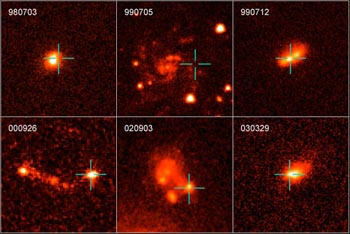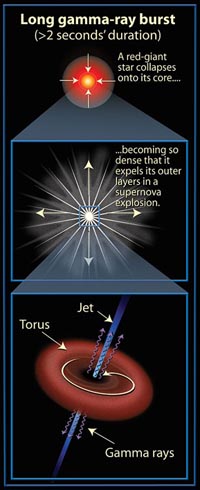|
Scientists
have now identified the types of galaxies where gamma-ray bursts
occur - and luckily ours isn't one of them.
by Meagan White
 Credit: NASA, ESA, Andrew Fruchter (STScI) and the GRB Optical Studies with HST (GOSH) Collaboration
Credit: NASA, ESA, Andrew Fruchter (STScI) and the GRB Optical Studies with HST (GOSH) Collaboration
A sampling
of the host galaxies of long-duration gamma-ray bursts taken
by NASA's Hubble Space Telescope.
|
|
Gamma-ray bursts don't loiter, and
neither can the people who hunt them. That's why astronomer Andy
Fruchter has set his cell phone to ring every time one of these
massive explosions - packed with the energy of a trillion suns -
occurs in outer space. Since the 1960s, when scientists scanning
the sky for elicit nuclear tests first witnessed these powerful
explosions and misconstrued them for Russian bombs, the origin of
gamma-ray bursts (GRBs) has been a mystery. But Fruchter's recent
attention to cosmic detail has filled in one of the gaps: he and
his team have identified the types of galaxies where these bursts
occur in a study published in Nature on May 10.
A GRB, best-described as a flash of very high-energy radiation, can be triggered by the collapse of a massive star. It is always accompanied by a supernova - another type of explosion resulting from the death of a star - and a GRB will be followed by a supernova instants later in a powerful succession of blows. However, although one might expect the two events to form in similar environments, images from the Hubble Telescope collected by Fruchter and other astronomers from the Space Telescope Science Institute in Baltimore show that they don't. In fact, the presence of a supernova doesn't always indicate that a GRB has occurred.
 Credit: NASA and A. Feild (STScI)
Credit: NASA and A. Feild (STScI)
A model
of a long-duration GRB.
|
This is where it gets tricky. Although
a GRB is a lot brighter than a supernova, and is observed first,
it is actually produced by the supernova, which is typically of
much higher energy. Sometimes the collapse of a star will only result
in a supernova: for a GRB to occur as well requires the right conditions.
Fruchter observed long-duration GRBs
(those lasting more than 2 seconds) and noticed that if a supernova
occurred in a massive - and older - galaxy, this supernova would
not have an associated GRB. He attributes this to the high metallicity
characteristic of older galaxies, where metal ions have had years
to accumulate, and suggests that GRBs can only be produced by supernovae
in galaxies with low metal levels.
Metallicity inhibits GRBS in two ways. First, metal ions in the atmosphere absorb emissions, or the gas jets, constituting a GRB, and this smothers the burst. Second, the magnetic field generated by the metal ions opposes and slows the rapid spin needed to generate a GRB. "Some supernovae would like to produce GRBs," explains Fruchter, "but they can't."
Luckily, these are the supernovae seen in massive, metal-rich, evolved galaxies, like ours. If a GRB were to occur in our Milky Way galaxy, it could destroy the ozone, start fires on Earth, cause mutations and even mass extinctions. So Fruchter says that one of the results of this study is: "Relax!" It is very unlikely that our galaxy will host such an explosion and the closest star where one could occur is about 150,000 light years away.
This reassuring conclusion has been
reached after painstakingly capturing images of GRBs with the Hubble
Telescope for the past 10 years. "There are well over 3000 gamma-
ray bursts known," Fruchter explains, "but only 40 or so for which
we have a good image." But the next time an image is captured, the
astronomers won't be so much wondering if it's close to home. Instead,
they will be using it to study star formation in the early universe.
Since GRBs are very bright, they are visible in areas where stars
have formed, whereas these areas are normally not observable using
telescopes available today.
For more information:
Andy Fruchter's GRB page - Hubble Space Telescope Observations of GRBs
http://www-int.stsci.edu/~fruchter/GRB/index.html
Space Daily - Earth Deemed Safe from Gamma-Ray Bursts
http://www.spacedaily.com/reports/Earth_Deemed_Safe_From_Gamma_Ray_Bursts.html
|
